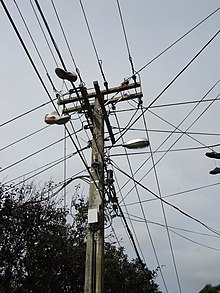
Back Leitungsmast German Στύλος κοινής ωφέλειας Greek Fosto Esperanto Poste Spanish تیر برق Persian עמוד חשמל HE उपयोगिता स्तम्भ Hindi Tiang utilitas ID Símastaur Icelandic 電柱 Japanese

A utility pole is a column or post, usually made out of wood or aluminum alloy,[1] used to support overhead power lines and various other public utilities, such as electrical cable, fiber optic cable, and related equipment such as transformers and street lights. It can be referred to as a transmission pole, telephone pole, telecommunication pole, power pole,[2] hydro pole,[3] telegraph pole, or telegraph post, depending on its application. A Stobie pole is a multi-purpose pole made of two steel joists held apart by a slab of concrete in the middle, generally found in South Australia.
Electrical wires and cables are routed overhead on utility poles as an inexpensive way to keep them insulated from the ground and out of the way of people and vehicles.[4] Utility poles can be made of wood, metal, concrete, or composites like fiberglass. They are used for two different types of power lines: sub transmission lines, which carry higher voltage power between substations, and distribution lines, which distribute lower voltage power to customers.
The first poles were used in 1843 by telegraph pioneer William Fothergill Cooke, who used them on a line along the Great Western Railway. Utility poles were first used in the mid-19th century in America with telegraph systems, starting with Samuel Morse, who attempted to bury a line between Baltimore and Washington, D.C., but moved it above ground when this system proved faulty. Today, underground distribution lines are increasingly used as an alternative to utility poles in residential neighborhoods, due to poles' perceived ugliness, as well as safety concerns in areas with large amounts of snow or ice build up.
- ^ "Choosing the Right Materials for Pole Upgrades". Utilities One. Archived from the original on 2024-02-21. Retrieved 2024-02-21.
- ^ "What is a Power Pole? Information on Power Poles in Australia". 2022-11-02. Retrieved 2024-02-21.
- ^ Barber, Katherine, ed. (1998). The Canadian Oxford dictionary. Toronto; New York: Oxford University Press. p. 695. ISBN 0-19-541120-X.
- ^ "Why are overhead transmission lines not insulated?". www.electricalclassroom.com. 2020-07-17. Retrieved 2024-02-21.
© MMXXIII Rich X Search. We shall prevail. All rights reserved. Rich X Search